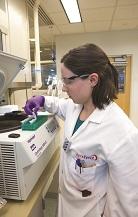

Manufacturing is the largest industry in Illinois, accounting for 13 percent of the state’s Gross Domestic Product. Nationally, Illinois is the third-largest manufacturing state and ranks fourth in overall manufacturing jobs, employing 577,400 workers, or about 10 percent of the state’s workforce. Manufacturers in Illinois serve a variety of industries, producing the second-largest output of rubber and plastics, printing support equipment and machinery manufacturing in the nation, and the fourth-largest output of electrical equipment, appliance manufacturing, fabricated metals and petroleum and coal manufacturing.
Industry giants Caterpillar Inc. and Deere & Co. have anchored agricultural manufacturing in Illinois since the turn of the 20th century, growing into billion-dollar international industries. Other Illinois-based companies such as Navistar have successfully transitioned from agricultural manufacturing to truck and diesel engine manufacturing with the support of Illinois’ job training programs. Illinois has experienced a growth in automobile manufacturing in the past few decades, attracting Chrysler and Ford to build or expand manufacturing plants across the state.
The development of advanced manufacturing technologies has opened up new opportunities for growth in Illinois. A cluster of more than 100 companies, including four Tier One companies, that engineer, manufacture and service aerospace and aviation technology and materials have turned the Rockford region into an internationally competitive hub of aerospace production. Companies such as Hamilton Sundstrand, Woodward, B/E Aerospace and GE Aviation have chosen to locate operations in Rockford in order to have easy access to the regional supply chain. Boeing’s corporate headquarters in Chicago is only a two-hour drive away.
Illinois is currently home to over 400 worldwide corporations and global headquarters and 33 Fortune 500 companies. This wide variety of companies and industries is succeeding in Illinois due to the state’s large transportation and logistics network, highly trained workforce and targeted public and private investment.

Businesses across the state benefit from Illinois’ extensive transportation network and robust logistics industry. Illinois’ location in nation’s heartland positions it at the center of cross country and international shipping, connecting rail lines from every corner of the country with easy access to North American markets in Canada and Mexico. The third-largest interstate highway system in the nation allows businesses to easily connect to markets across the region, as well as international markets via the state’s three international airports and the nation’s second-largest rail system. Illinois’ waterways, including the Mississippi River, Illinois River, Ohio River and Lake Michigan, connect the state to domestic and international markets, shipping approximately 116 million tons of commodities a year valued at $23 billion.1 Access to the Gulf of Mexico via the Mississippi and the Atlantic Ocean via the Great Lakes and the Saint Lawrence Seaway facilitate easy international shipping by barge.
Chicago serves as a transport hub for both the state and nation. The largest rail hub in the United States, Chicago offers businesses access to six Class I railroad lines. The Port of Chicago, the leading intermodal container handler in the western hemisphere and the third-largest intermodal port in the world, handles almost 20 million tons of cargo annually2. Chicago’s two international airports, O’Hare and Midway, offer the most flights in the U.S., facilitating easy international businesses travel. A third international airport, and second-fastest-growing cargo airport in the country, is a short distance away in Rockford.

A world-renowned cultural scene, family-friendly recreational activities and affordable cost of living attract a diverse, well-educated population to Illinois. Chicago ranks in the top 15 best areas for millennials3, with the city’s concentration of world-class universities and growing tech sector attracting young people from across the country.
One third of the state’s 6.6 million-person workforce has achieved a bachelor’s degree or higher, a testament to the 200 higher education institutions and 48 community colleges throughout Illinois. Higher education institutions in Illinois have proven willing to partner with businesses in creating career-focused, need-driven workforce development programs to keep Illinois’ workforce competitive and prepare students for in-demand 21st century careers.
The concentration of research universities in Illinois has produced fruitful opportunities for public-private collaboration on research and development, attracting talented, innovative researchers and helping Illinois’ businesses remain on the cutting edge. Funding for research and development in Illinois is outpacing the rest of the nation, with over $2.4 billion available annually for R&D and over $1.5 billion in federal funding, including contracts with the National Science Foundation and the U.S. Department of Energy.

Last year, construction began on the ground-breaking Digital Manufacturing and Design Innovation Institute (DMDII), the product of a partnership between the state, research universities, the U.S. Department of Defense and the private sector. DMDII connects businesses with academic institutions, governments and nonprofits to develop technology that will transform and reinvigorate American manufacturing. The Institute will support the development of digital manufacturing and design technologies to help American manufacturers cut costs and remain globally competitive, while training a growing workforce in emerging manufacturing technologies. DMDII will cement Illinois’ position as a leader in advanced manufacturing.
Illinois’ Future
While Chicago is affectionately referred to as the ‘Second City,’ Illinois is committed to becoming No. 1 in the nation in business development and growth. Governor Bruce Rauner is committed to enacting structural reforms to make it easier for businesses to grow and thrive in Illinois. Under Governor Rauner, the state’s Department of Commerce and Economic Opportunity (DCEO) aims to increase business creation by reducing the costs and red tape associated with starting a business. Governor Rauner and DCEO are committed to growing a diverse business community in Illinois and the department is in the process of developing new initiatives to encourage more women-, minority- and veteran-owned business in Illinois. With a strong focus on structural reform, Governor Rauner has dedicated himself to putting the state of Illinois on the path to a growing economy and more welcoming business climate.
References
1) ASCE’s Report Card for IllinoisInfrastructure http://www.theportofchicago.com/news/newspdfs/2014-Illinois-Infrastructure-2Page-Report-Card.pdf
2) Illinois International Port District http://www.iipd.com/about/facts-stats.htm
3) NBC Chicago http://www.nbcchicago.com/news/local/Chicago-Named-Among-Top-Metro-Areas-for-Millennials-304862991.html

